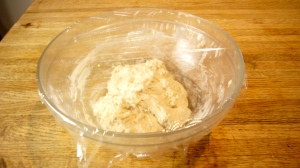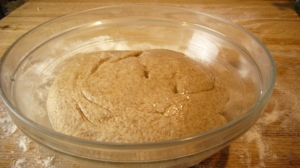Andrew Jajigian wrote the article on whole wheat bread. He explains that it is the gluten in flour that gives bread it’s lift and structure. Wheat bran, which gives whole wheat flour it’s distinctive flavor, actually impedes the development of gluten and its sharp edges cut and puncture the dough.
Janjigian discovered a number of whole wheat recipes that called for soaking the whole wheat flour overnight. And this, he writes, is the key to a light, whole wheat sandwich loaf. So this week I’m trying Jajigan’s recipe.
Ingredients
For the starter
- 2 cups white bread flour
- 1 cup warm water
- ½ teaspoon dry yeast.
For the soaked whole wheat flour
- 3 cups whole wheat flour, plus extra for kneading
- ½ cup wheat germ
- 2 cups whole milk
To add to the dough
- ¼ cup honey
- 4 teaspoons table salt
- 2 tablespoons dry yeast
- 6 tablespoons unsalted butter, softened
- 2 tablespoons vegetable oil
Preparation (Please go the original article for a more complete version of the preparation and the reasons for taking each step. My cut-down version may not do it justice, but if you can’t find the original, this will make a great loaf).
 Friday night, I mixed the starter and put it on the back of the stove in a tightly covered bowl.
Friday night, I mixed the starter and put it on the back of the stove in a tightly covered bowl.
I combined the whole wheat flour, wheat germ and milk, kneaded it slightly to make a ball, and put the ball in a tightly covered container in the refrigerator.
flour, wheat germ and milk, kneaded it slightly to make a ball, and put the ball in a tightly covered container in the refrigerator.
Saturday afternoon, I broke the soaked whole wheat-flour into 1 inch chunks and mixed it with the starter and additional dough ingredients in the bowl of an electric mixer. I’ve never used the kneading tool on my mixer, so this was new to me, but Janjigian says hand kneading tends to add too much flour to the dough, making the loaf slightly tougher. I mixed the ingredients together at a low speed. This was more difficult than I imagined, and I had to use a plastic spatula to force the soaked flour into the center of mixing bowl. When it was finally combined, the dough seemed way too wet, and I added a half cup each of whole wheat and white flour. Then I ran the mixer at medium for ten minutes.
I’ve never used the kneading tool on my mixer, so this was new to me, but Janjigian says hand kneading tends to add too much flour to the dough, making the loaf slightly tougher. I mixed the ingredients together at a low speed. This was more difficult than I imagined, and I had to use a plastic spatula to force the soaked flour into the center of mixing bowl. When it was finally combined, the dough seemed way too wet, and I added a half cup each of whole wheat and white flour. Then I ran the mixer at medium for ten minutes.
The dough was now a coherent lump adhering to the kneading tool. I pulled it off and returned it to the floured kneading surface and kneaded it, adding a little more flour, for about a minute or two. Then I shaped it into a ball and put it into an oiled bowl, turning once to cover the top with oil, and I covered the bowl and left it rise at room temperature for 45 minutes.
After 45 minutes, I gently pushed down the center of the dough and folded one side into the middle. As directed, I repeated this for eight folds and then covered the bowl again and let the dough rise until double in bulk. This took about an hour.
Finally, I used Janjigian’s method of shaping the two loaves. Divide the dough in half, pat into 8 X 17 inch rectangles and roll the dough up to form two cylinders. Put them seam side down into two 8 ¼ X 4 ½ inch loaf pans. (My pans were 5 X 9 but they worked okay). Again, let them rise until almost double in bulk — an hour to an hour and half.
Preheat the oven to 400 degrees. Bake the bread on a shelf in the middle of the oven. Put a pan of boiling water on the lower shelf. Lower the temperature immediately to 350 and cook until golden brown. Janjigian advises baking the bread on a baking stone, but I don’t have one and the bread seemed to work fine without.
This bread is truly delicious and perfect for sandwiches!
